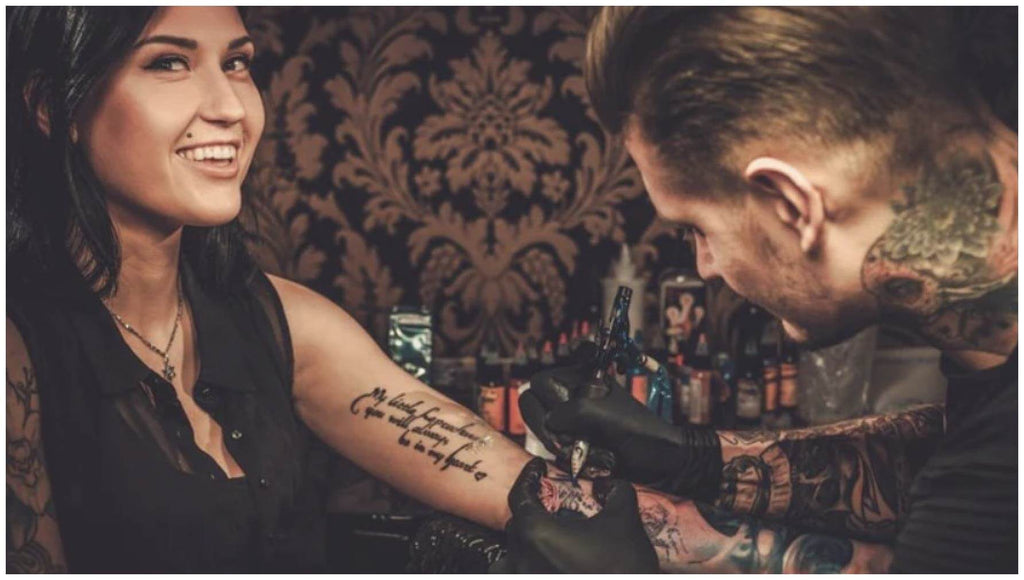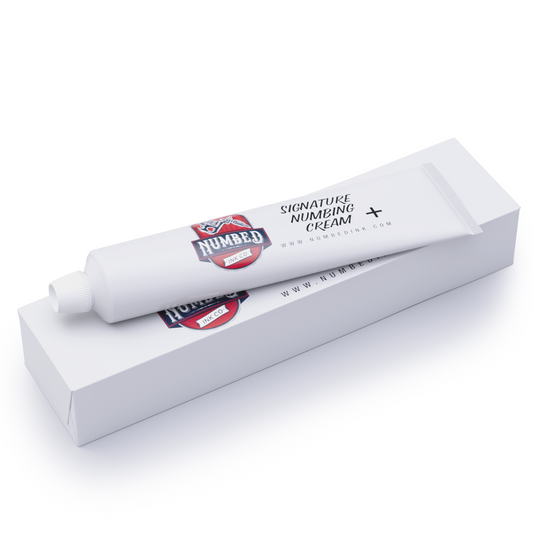Tattoos have been around for over 20,000 years. And though the principles remain the same, many parts of the process have changed. Even in the last few years, new tattoos have become less painful thanks to tattoo numbing creams.
These creams are applied directly to the skin to reduce the typical pain associated with new ink. They’ve benefitted many ink enthusiasts and artists alike, improving the often difficult and painful process.

And even though using them may seem like a no-brainer, not everyone likes them. They’re a hot topic, sparking debates across the tattoo community.
But if you're afraid to ask your artist if they use tattoo numbing creams, don't worry. We already asked real artists (and clients). Here's what they had to say.
Do tattoo artists use numbing cream?
Many artists are happy to use and even provide numbing cream for your session, while others refuse to use it. And their reasoning might surprise you.
Artists that are pro-numbing cream argue that it helps them work more efficiently with fewer interruptions. This means less time under the needle for the client.
On the other hand, many artists maintain that pain is part of the process, a right of passage that “completes” your tattoo.
There are also plenty of artists that fall in the middle of this debate. Some use numbing creams but only if the client supplies it themselves. Others may use a certain brand if they have a preferred brand or partnership.
Because it’s such a hot topic, we asked real artists to give their input on whether or not they use tattoo numbing cream.
But first…
What is tattoo numbing cream?
Tattoo numbing cream is a topical skin numbing product that acts as a local anesthetic to make the tattoo process less painful. Most creams last between 4-6 hours.
There are several types of numbing creams – nerve deadeners, nerve blockers, and vasoconstrictors. Each uses different combinations of ingredients to achieve a numbing effect.
Nerve deadeners are the most common and work by temporarily deadening the nerves in your skin to prevent them from registering pain. The active ingredient is lidocaine, a local anesthetic commonly used for minor medical procedures.
Many artists like to use tattoo numbing creams
From an artist’s perspective, numbing creams have one big selling point – efficiency. Because the client will feel little to no pain, artists can work without breaks or interruptions. This means that they can work at their own pace, not the client’s.
Similarly, numbing agents reduces the amount of time needed for a large piece. Rather than split a big upper thigh piece over 2-3 sessions, artists can do it all at once, freeing up time for other clients.
With fewer breaks and streamlined sessions, artists can schedule more clients over the course of the day.
As a client, there are plenty of benefits to using tattoo numbing cream. They enable you to sit pain-free for several hours, even if it’s a sensitive area like your ribs or top of your feet.
Pain is one of the biggest reasons why many people don’t have any tattoos. And while some argue that pain is a part of the process, it’s also completely subjective. People with lower pain tolerances and certain medical conditions simply may not be able to get a tattoo in the “traditional” way.
But that shouldn’t stop them. With numbing creams, they can get the ink they’ve always wanted without worrying about how much pain it will cause.
And even if “you’ve been getting tattoos for 30 years and had to suffer through every one until now,” that doesn’t mean that your next one has to be painful too. You won’t have to “feel one sharp poke… for hours of tattooing” says Jason, a chronic ink enthusiast.

But some don't
Artists that don’t use numbing creams suggest that it disrupts the tattoo process. Tattoos have been around since 3300 B.C. and they don’t want to break tradition.
Most of these artists only use it if the client brings it and applies it themselves, though they may be reluctant to do so. But some artists refuse to use them entirely, even if the client provides their own.
Just as with any local anesthesia, there are medical risks. If applied incorrectly, the artist will have to spend extra time wiping away the excess cream, according to The Skin Museum.
And with cheaper creams, some artists notice that the client experiences greater pain as the numbness starts to wear off. Because the client was expecting complete numbing, the pain is often exaggerated.
Here’s what to do if you want to use numbing cream
If you want to use tattoo numbing cream, you should. And there’s no need to feel bad about it. But there are a few things you should know first.
Should I tell my tattoo artist that I plan to use a numbing cream?
Yes, it’s better to ask for permission than to ask for forgiveness. Jon Reiter, a veteran at Solid State Tattoos in Milwaukee, recommends that you notify your artists as soon as possible that you plan to use numbing cream. Otherwise you may face an awkward conversation when you show up with numbing cream that your artist didn’t know about.
And if you're wondering if they can tell whether you used it or not, they can. Many creams have odors and they'll be able to feel the texture difference on your skin.
But don’t just ask if they’ll use it – ask detailed questions to put your mind at ease. See if they’ve used it before and if they have a preferred brand. If you’re planning to use your own, make sure to check with them before doing so.
If the artist has to make major adjustments or wait for the numbness to kick in, you may have to pay for extra time. Some artists may cancel on you altogether, leaving you with a lot of wasted time and money.
Most artists prefer to use them while others refuse to work with them. Regardless of their preferences, it’s important to respect their decision and their artwork. You wouldn’t tell Picasso how to paint and you shouldn’t tell an artist how to do their job.
If you want to use a numbing cream for your next tattoo, just ask your artist!



